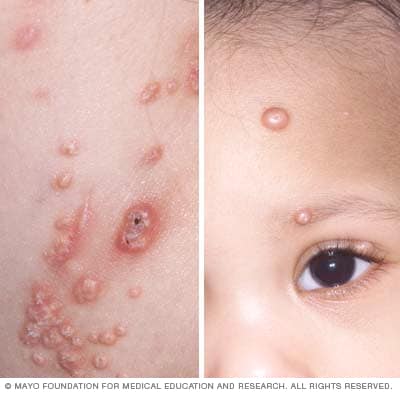Molluscum contagiosum is a viral infection that causes small, white or pink pimple-like skin lesions.
The infection most commonly affects children between ages 1 and 10 years, but it can also affect adults.
Causes and Risk Factors of Molluscum Contagiosum
Molluscum contagiosum is caused by the molluscum contagiosum virus, a type of poxvirus. Poxviruses are a family of viruses that’s responsible for smallpox, among other diseases.
Molluscum contagiosum is contagious and it spreads easily. You can catch the virus through direct skin-to-skin contact with someone who has it and, once you have the infection, you can spread it to other areas of your body simply by touching the lesion and then touching elsewhere on your skin.
Aside from person-to-person contact, the virus can also be passed between people through contaminated objects, such as towels, clothing, and toys, as well as from contaminated surfaces in facilities such as pools and daycare centers.
Molluscum contagiosum thrives in warm, humid environments, so you’re more likely to get the condition if you live in a tropical climate.
Having atopic dermatitis (the most common type of eczema) or a weakened immune system, such as from HIV or AIDS, also increases your risk of getting the condition.
Duration of Molluscum Contagiosum
The condition is more likely to persist in people with a weakened immune system, such as those with HIV.
Complications of Molluscum Contagiosum
Even if you recover from a molluscum contagiosum infection, you can still get infected again if you come in contact with another infected person or object.
The lesions caused by molluscum contagiosum typically resolve without scarring. However, scratching at the lesion, or physically removing the lesion, can cause scarring.
For this reason, physically removing the lesion isn’t recommended in otherwise healthy people.
Health problems that can occur if you or your child don’t take steps to treat or prevent molluscum contagiosum include:
- Persistence, spread, or recurrence of molluscum contagiosum lesions
- Spread of lesions to other parts of the body
- In some cases, secondary bacterial skin infections
A secondary infection caused by bacteria is the most common complication of molluscum contagiosum. Such secondary infections may cause serious health problems in people who are immunocompromised, such as those with HIV or AIDS, or those taking immunosuppressing drug therapies.
Related Conditions and Causes of Molluscum Contagiosum
Because molluscum contagiosum spreads through sexual contact in teens and adults, it may be considered a sexually transmitted disease (STD). In fact, lesions on the genitals caused by the condition may be mistaken for herpes sores or warts, at least initially.
However, unlike in herpes, molluscum contagiosum lesions are painless.
Molluscum Contagiosum Resources
American Academy of Dermatology
The AAD site describes the role dermatologists play in diagnosing and treating molluscum contagiosum, as well as an overview of available therapies. The site can also connect you with a dermatologist in your area if you think you may have molluscum contagiosum or another skin condition.
U.S. Centers for Disease Control and Prevention
The CDC offers information on outbreaks of molluscum contagiosum across the country, as well as additional resources for more information on the condition.
Additional reporting by Joseph Bennington-Castro.
Editorial Sources and Fact-Checking
- Molluscum Contagiosum. Centers for Disease Control and Prevention. May 11, 2015.
- Schaffer JV, Berger EM. Molluscum Contagiosum. JAMA Dermatology. September 2016.
- Molluscum Contagiosum. MedlinePlus. April 16, 2019.
- Molluscum Contagiosum: Diagnosis and Treatment. American Academy of Dermatology.
- Becker TM, Blount JH, Douglas J, Judson FN. Trends in Molluscum Contagiosum in the United States, 1966-1983. Sexually Transmitted Diseases. April–June 1986.













































